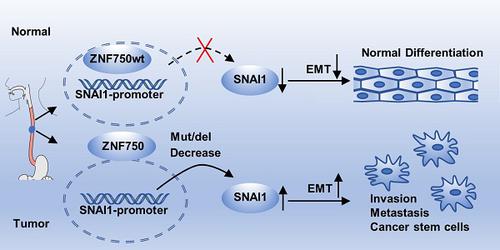Theranostics ( IF 12.4 ) Pub Date : 2020-01-01 , DOI: 10.7150/thno.38210 Pengzhou Kong 1 , Enwei Xu 1 , Yanghui Bi 1 , Xiaoqin Xu 1 , Xue Liu 1 , Bin Song 1 , Ling Zhang 1 , Caixia Cheng 1 , Ting Yan 1 , Yu Qian 1 , Jian Yang 1 , Yanchun Ma 1 , Heyang Cui 1 , Yuanfang Zhai 1 , Binbin Zou 1 , Xiangchen Liu 1 , Yikun Cheng 2 , Shiping Guo 3 , Xiaolong Cheng 1 , Yongping Cui 1

|
Background: Cancer genomic studies have identified Zinc Finger Protein 750 (ZNF750) was a novel significantly mutated gene in esophageal squamous cell carcinoma (ESCC). This study was designed to determine the clinical value and molecular mechanisms of ZNF750 in the development of ESCC.
Methods: Genomic data from 4 reported ESCC cohorts were used to analyze the mutation profile of ZNF750. Tissue microarrays were used to detect its expression in 308 ESCC samples. Furtherly, the effects of ZNF750 on proliferation, colony formation, migration and invasion were tested in ESCC cells. PCR-array, chromatin immunoprecipitation (ChIP), luciferase reporter assays, and rescue assay were used to explore the mechanism of ZNF750. Correlation of ZNF750 with its target genes was analyzed in TCGA data from various SCC types.
Results: ZNF750 was frequently mutated in ESCC and the most common type was nonsense mutation. Its nucleus/cytoplasm ratio in ESCC was significantly lower than that in paired non-tumor tissues; it was an independent and potential predictor for survival in ESCC patients. Furtherly, ZNF750 knockdown significantly promoted proliferation, colony formation, migration and invasion in ESCC cells. PCR-array showed epithelial-to-mesenchymal transition (EMT) was the main biologic process affected by ZNF750. Moreover, ZNF750 directly bound to the promoter region of SNAI1 and depressed its activity. Decreased ZNF750 up-regulated SNAI1 expression and promoted EMT phenotype. SNAI1 knockdown partially reversed the malignant phenotype induced by ZNF750 knockdown. Further TCGA data analyses showed ZNF750 expression was positively correlated with E-cadherin and negatively correlated with SNAI1, N-cadherin and Vimentin in ESCC and other SCC samples.
Conclusion: Our results suggest that ZNF750 may act as a tumor suppressor by directly repressing SNAI1 and inhibiting EMT process in ESCC and other types of SCC.
中文翻译:

与ESCC相关的新基因ZNF750作为潜在的预后生物标志物,可通过直接抑制ESCC中的SNAI1启动子来抑制上皮-间质转化。
背景:癌症基因组学研究已经确定,锌指蛋白750(ZNF750)是食管鳞状细胞癌(ESCC)的一种新型显着突变基因。本研究旨在确定ZNF750在食管鳞癌发展中的临床价值和分子机制。
方法:使用来自4个报告的ESCC队列的基因组数据来分析ZNF750的突变谱。组织微阵列用于检测其在308个ESCC样品中的表达。此外,在ESCC细胞中测试了ZNF750对增殖,集落形成,迁移和侵袭的作用。通过PCR-阵列,染色质免疫沉淀(ChIP),荧光素酶报告基因检测和拯救检测来研究ZNF750的机制。在来自各种SCC类型的TCGA数据中分析了ZNF750及其靶基因的相关性。
结果:ZNF750在ESCC中经常发生突变,最常见的类型是无意义的突变。在ESCC中,它的细胞核/细胞质比明显低于成对的非肿瘤组织。它是ESCC患者生存的独立且潜在的预测指标。此外,ZNF750敲低显着促进了ESCC细胞的增殖,集落形成,迁移和侵袭。PCR芯片显示上皮到间质转化(EMT)是受ZNF750影响的主要生物过程。此外,ZNF750直接结合到SNAI1的启动子区域,并降低其活性。减少ZNF750上调SNAI1表达并促进EMT表型。SNAI1敲低部分逆转了ZNF750敲低诱导的恶性表型。
结论:我们的结果表明ZNF750可能通过直接抑制SNAI1并抑制ESCC和其他类型SCC中的EMT过程而发挥抑癌作用。











































 京公网安备 11010802027423号
京公网安备 11010802027423号